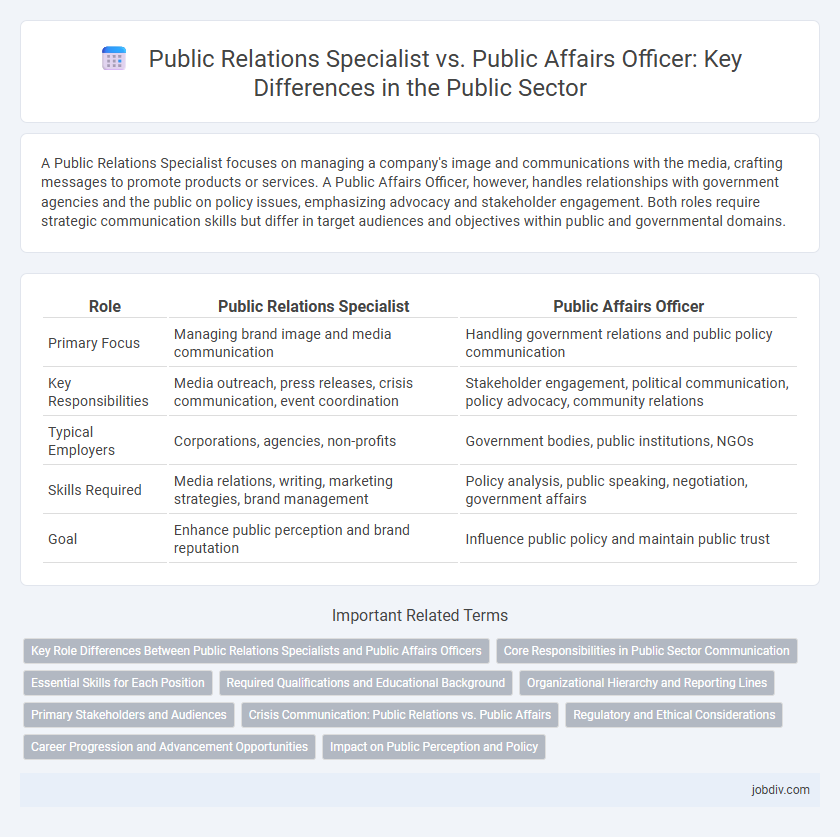A Public Relations Specialist focuses on managing a company's image and communications with the media, crafting messages to promote products or services. A Public Affairs Officer, however, handles relationships with government agencies and the public on policy issues, emphasizing advocacy and stakeholder engagement. Both roles require strategic communication skills but differ in target audiences and objectives within public and governmental domains.
Table of Comparison
| Role | Public Relations Specialist | Public Affairs Officer |
|---|---|---|
| Primary Focus | Managing brand image and media communication | Handling government relations and public policy communication |
| Key Responsibilities | Media outreach, press releases, crisis communication, event coordination | Stakeholder engagement, political communication, policy advocacy, community relations |
| Typical Employers | Corporations, agencies, non-profits | Government bodies, public institutions, NGOs |
| Skills Required | Media relations, writing, marketing strategies, brand management | Policy analysis, public speaking, negotiation, government affairs |
| Goal | Enhance public perception and brand reputation | Influence public policy and maintain public trust |
Key Role Differences Between Public Relations Specialists and Public Affairs Officers
Public Relations Specialists primarily manage communication strategies to enhance brand reputation and engage media and audiences, focusing on marketing and promotional activities. Public Affairs Officers concentrate on government relations, policy advocacy, and community engagement, often working within public sector organizations to influence public policy and maintain stakeholder relationships. The key role difference lies in PR Specialists targeting public perception through media channels, while Public Affairs Officers focus on policy impact and regulatory environments.
Core Responsibilities in Public Sector Communication
Public Relations Specialists manage media relations, craft press releases, and oversee communication strategies to enhance an organization's public image. Public Affairs Officers engage with government agencies, monitor policy developments, and facilitate stakeholder relations to influence public policy and advocate organizational interests. Both roles require expertise in strategic communication but differ in focus: Public Relations Specialists emphasize image management, while Public Affairs Officers prioritize policy influence within the public sector.
Essential Skills for Each Position
Public Relations Specialists excel in media communication, content creation, and brand management, emphasizing persuasive messaging and audience engagement to shape public perception. Public Affairs Officers require expertise in government relations, policy analysis, and stakeholder collaboration to influence public policy and maintain organizational credibility. Both roles demand strong communication and crisis management skills, yet the former prioritizes media strategy while the latter centers on political navigation and advocacy.
Required Qualifications and Educational Background
Public Relations Specialists typically require a bachelor's degree in communications, marketing, or journalism, with skills in media relations, content creation, and public speaking being essential. Public Affairs Officers often need a background in political science, public administration, or international relations, along with experience in government or policy analysis. Both roles emphasize strong communication abilities, but Public Affairs Officers may require additional knowledge of legislative processes and community engagement.
Organizational Hierarchy and Reporting Lines
Public Relations Specialists typically report to the Communications Manager or Director within the marketing or communications department, focusing on managing media relations and crafting public messages. Public Affairs Officers often hold a position within government agencies or large corporations, reporting directly to senior executives or department heads responsible for policy and stakeholder engagement. Organizational hierarchy places Public Affairs Officers higher in strategic decision-making due to their focus on regulatory and community relations, whereas Public Relations Specialists operate more tactically within communication teams.
Primary Stakeholders and Audiences
Public Relations Specialists primarily engage with media outlets, customers, and the general public to shape brand reputation and manage communication strategies. Public Affairs Officers focus on government officials, policymakers, and community leaders to influence public policy and foster government-community relations. Understanding the distinct primary stakeholders allows tailored messaging that aligns with organizational goals and regulatory environments.
Crisis Communication: Public Relations vs. Public Affairs
Crisis communication in Public Relations centers on managing a brand's reputation by quickly addressing negative publicity and maintaining stakeholder trust through targeted messaging and media engagement. Public Affairs Officers focus on influencing public policy and government relations during crises, strategically navigating legal and regulatory frameworks to protect organizational interests and ensure compliance. Both roles require clear, timely communication but differ in audience focus: Public Relations targets the general public and consumers, while Public Affairs prioritizes government officials and policy influencers.
Regulatory and Ethical Considerations
Public Relations Specialists navigate media communications and brand reputation while adhering to advertising standards and transparency regulations, ensuring ethical messaging to the public. Public Affairs Officers engage with government agencies and policymakers, focusing on compliance with lobbying laws, government transparency, and ethical standards in public policy communication. Both roles require strict adherence to regulatory frameworks such as the Federal Trade Commission (FTC) guidelines and the Honest Leadership and Open Government Act to maintain public trust and legal integrity.
Career Progression and Advancement Opportunities
Public Relations Specialists typically advance by honing media relations, content creation, and brand management skills, often progressing to roles such as PR Manager or Communications Director within corporate or agency settings. Public Affairs Officers focus on government relations, policy communication, and stakeholder engagement, moving up to positions like Public Affairs Manager or Government Relations Director in public sector organizations. Career progression in public affairs often involves deeper expertise in legislative processes and community outreach, while PR specialists emphasize strategic messaging and reputation management across diverse industries.
Impact on Public Perception and Policy
Public Relations Specialists shape public perception by crafting strategic communication campaigns to enhance brand or organizational image, emphasizing media relations and audience engagement. Public Affairs Officers influence policy by managing interactions between governmental bodies and the public, focusing on legislative advocacy and regulatory compliance. Both roles critically intersect in managing stakeholder trust, but Public Affairs Officers prioritize policy impact while Public Relations Specialists center on reputation management.
Public Relations Specialist vs Public Affairs Officer Infographic

 jobdiv.com
jobdiv.com